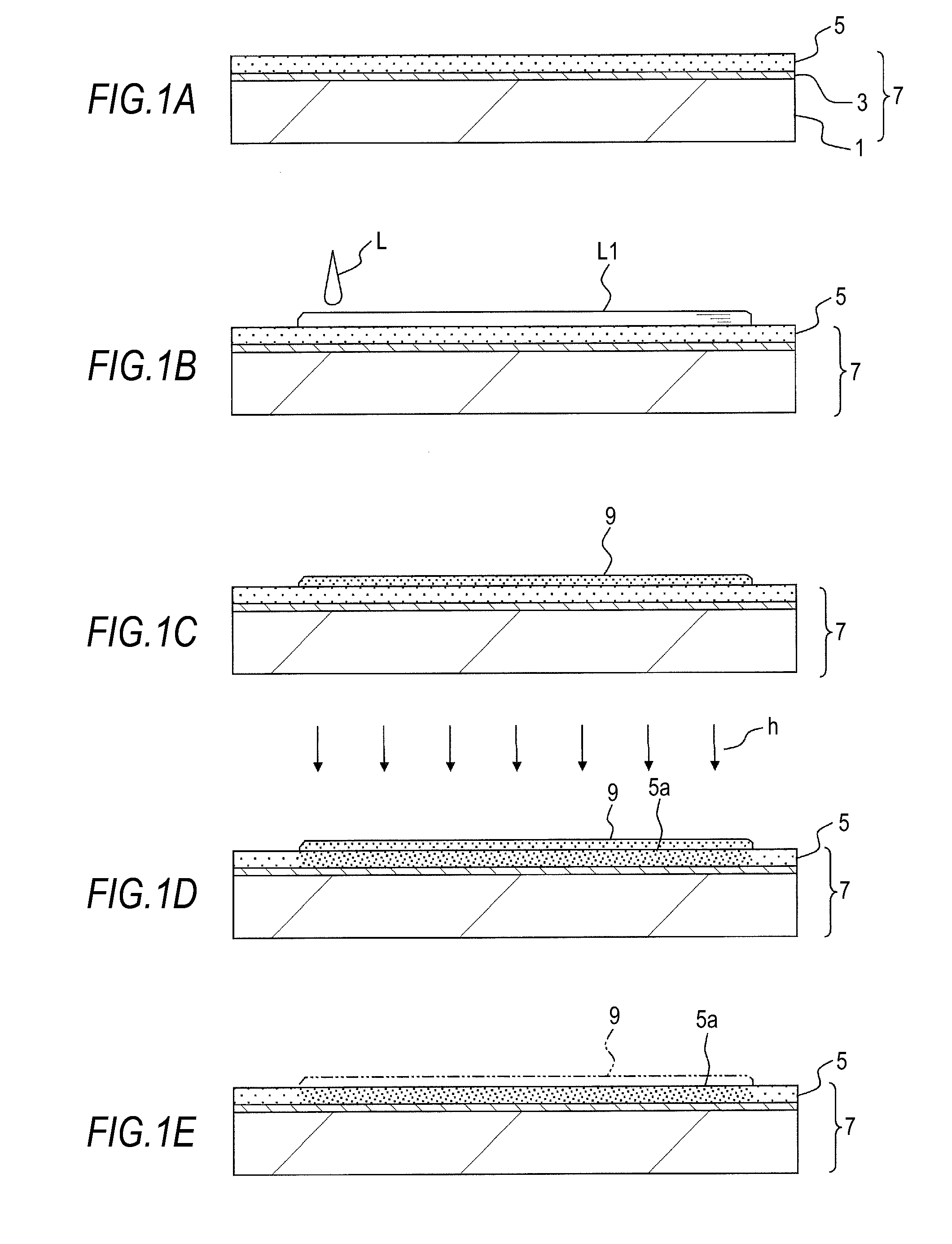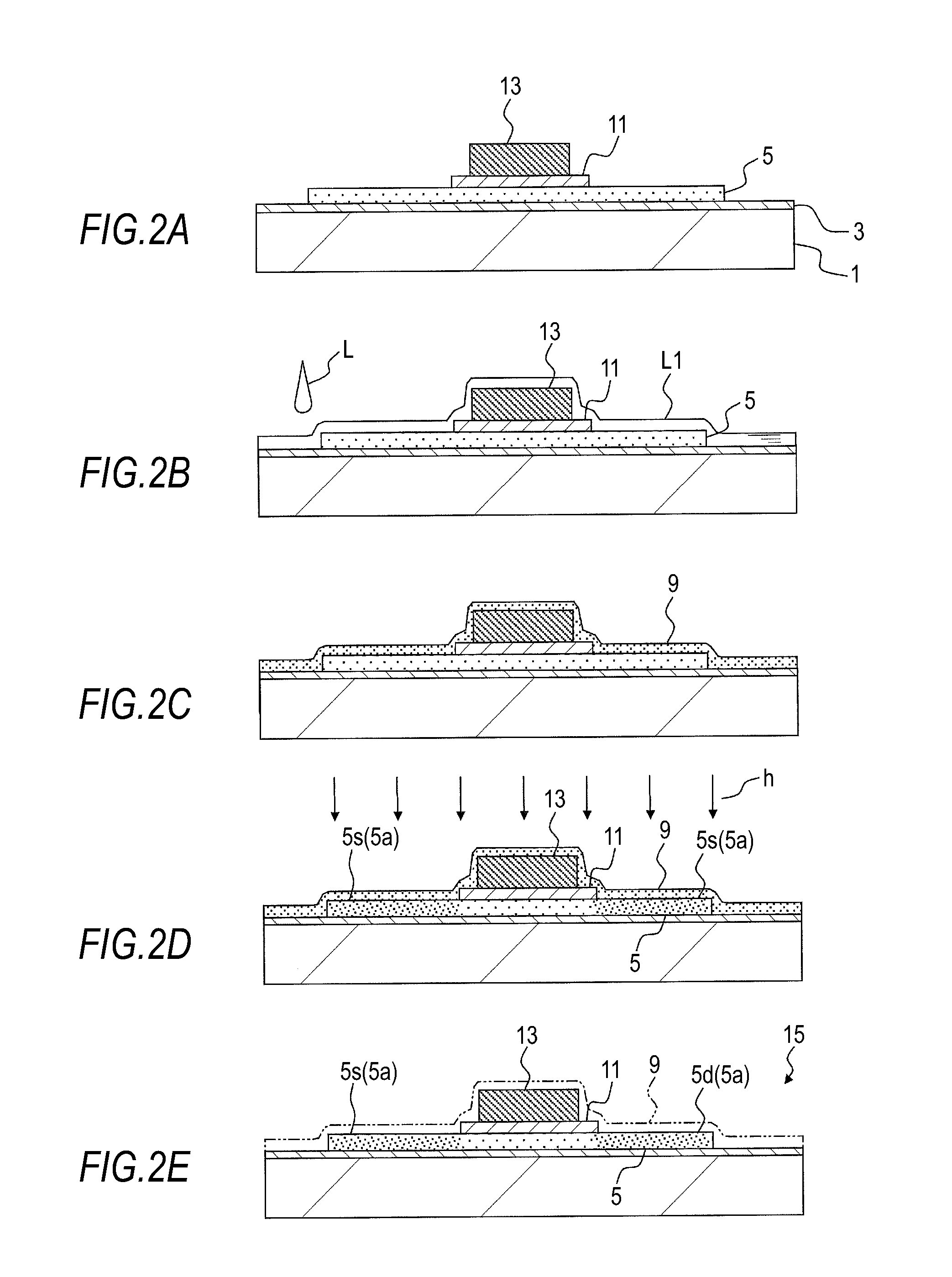Doping method, and method for producing semiconductor device
a technology of semiconductor devices and impurities, which is applied in the direction of semiconductor devices, basic electric elements, electrical appliances, etc., can solve the problems of property degradation of the semiconductor layer, difficult to obtain the desired properties of the semiconductor device, and the above-mentioned doping methods to control the concentration of impurities used to dope the semiconductor layer. achieve the effect of high accuracy and well-controlled properties
- Summary
- Abstract
- Description
- Claims
- Application Information
AI Technical Summary
Benefits of technology
Problems solved by technology
Method used
Image
Examples
first embodiment
[0023]FIGS. 1A to 1E show a flow chart illustrating a doping method according to this embodiment in cross section. The following will describe the doping method based on these figures.
[0024]First, as shown in FIG. 1A, a supporting substrate 1 is prepared, and a buffer layer 3 made of an insulating material such as silicon oxide or silicon nitride is formed thereon. The supporting substrate 1 used here is a crystalline or amorphous substrate. Examples of crystalline substrates include a semiconductor substrate and a quartz substrate. Preferred examples of amorphous substrates include those that have low thermal resistance (low melting point) but allow the production of large-area substrates easily at low cost, such as those made of glass or an organic polymeric material (plastic). If necessary, the supporting substrate 1 may have flexibility.
[0025]Subsequently, a semiconductor layer 5 is formed on the supporting substrate 1 having formed thereon the buffer layer 3. The semiconductor ...
second embodiment
[0040]FIGS. 2A to 2E show a flow chart illustrating a method for producing a semiconductor device according to a second embodiment in cross section, which applies the doping method of the first embodiment. FIGS. 2A to 2E show the production of a semiconductor device configured as a thin-film transistor with an offset structure. The following describes the method for producing a semiconductor device based on these figures. The components common to the first embodiment are indicated with the same reference numerals, and will not be further described.
[0041]First, as shown in FIG. 2A, a semiconductor layer 5 is formed on a supporting substrate 1 with a buffer layer 3 therebetween, and, if necessary, the semiconductor layer 5 is patterned into islands and crystallized.
[0042]Next, across the semiconductor layer 5 in the form of islands, a gate insulating film 11 is formed above the supporting substrate 1 and then patterned. The gate insulating film 11 formed here is made of silicon oxide,...
third embodiment
[0052]FIGS. 3A to 3E and 4A to 4E show a flow chart illustrating a method for producing a semiconductor device according to another embodiment in cross section, which applies the doping method of the first embodiment. These figures show the production of a semiconductor device configured as a thin-film transistor with a LDD structure. The following describes the method for producing a semiconductor device based on these figures. The components common to the first and second embodiments are indicated with the same reference numerals, and will not be further described.
[0053]First, as shown in FIG. 3A, a semiconductor layer 5 is formed on a supporting substrate 1 with a buffer layer 3 therebetween, and, if necessary, the semiconductor layer 5 is patterned into islands and crystallized.
[0054]Next, across the semiconductor layer 5 in the form of islands, a gate insulating film 11 and a gate electrode 13 are formed in the same pattern above the supporting substrate 1. The gate insulating ...
PUM
| Property | Measurement | Unit |
|---|---|---|
| thick | aaaaa | aaaaa |
| concentration | aaaaa | aaaaa |
| semiconductor | aaaaa | aaaaa |
Abstract
Description
Claims
Application Information
 Login to View More
Login to View More - R&D
- Intellectual Property
- Life Sciences
- Materials
- Tech Scout
- Unparalleled Data Quality
- Higher Quality Content
- 60% Fewer Hallucinations
Browse by: Latest US Patents, China's latest patents, Technical Efficacy Thesaurus, Application Domain, Technology Topic, Popular Technical Reports.
© 2025 PatSnap. All rights reserved.Legal|Privacy policy|Modern Slavery Act Transparency Statement|Sitemap|About US| Contact US: help@patsnap.com



